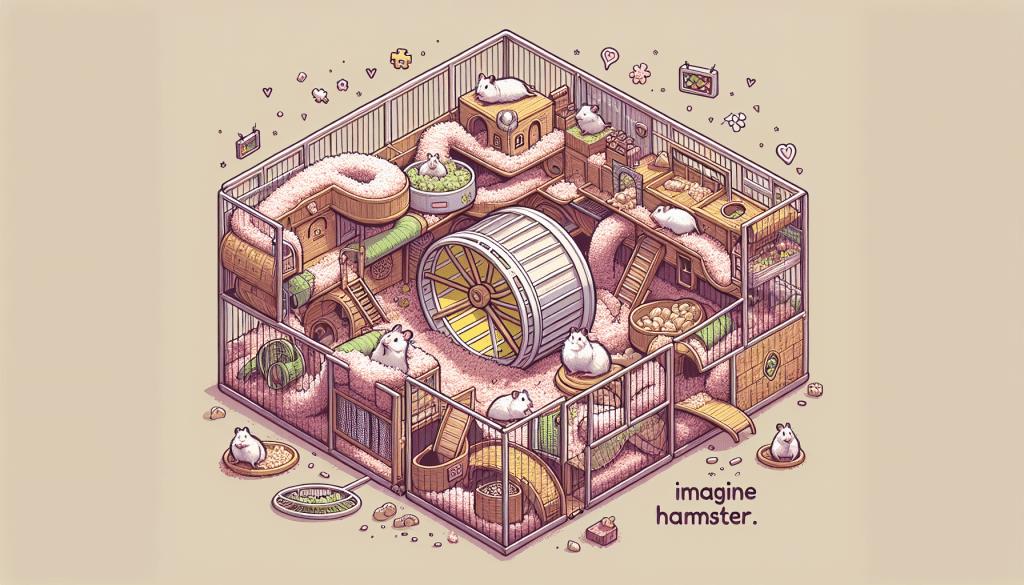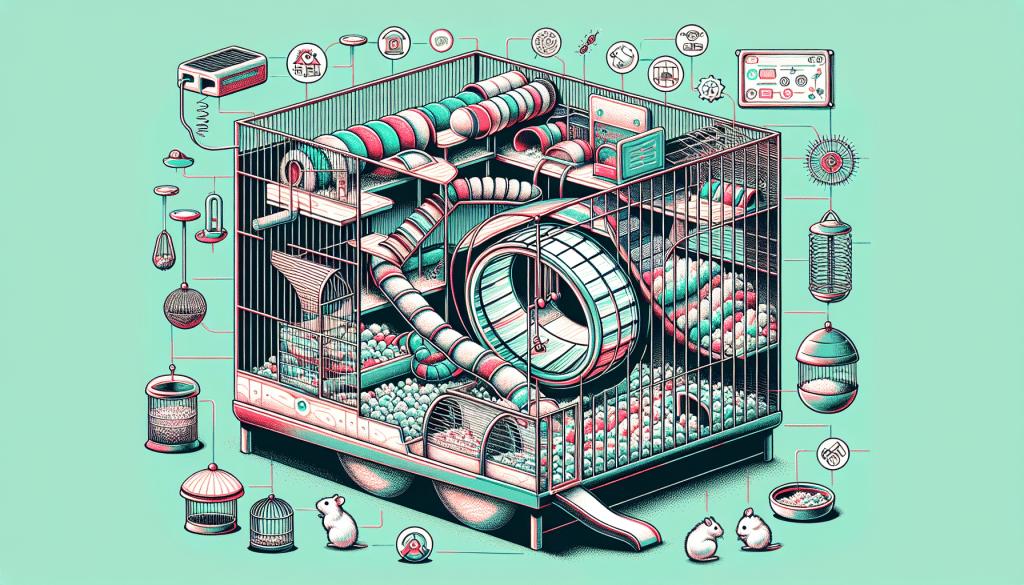If you have a hamster as a pet, it is important to make sure they have the best home possible. In order to create the perfect hamster habitat, you need to provide them with a comfortable and safe space to live in. This means giving them a spacious cage with plenty of bedding, toys to keep them entertained, and a wheel for them to exercise on. It’s also important to keep their cage clean and provide them with fresh food and water. By creating the perfect hamster habitat, you can ensure that your furry friend is happy and healthy.

Understanding Hamster Needs
Hamsters have specific requirements that need to be met in order for them to be healthy and happy. As a responsible hamster owner, it is important to understand these needs and provide for them accordingly.
Species-specific Requirements
Different species of hamsters have different needs. The most common pet hamster species are Syrian hamsters, dwarf hamsters, and Roborovski hamsters. Each of these species has its own unique characteristics and requirements. It is important to do some research and understand the specific needs of the species you own.
Natural Behaviors
Hamsters are burrowing animals by nature, so it is important to provide them with opportunities to engage in this natural behavior. They love to dig and create tunnels, so you should provide them with appropriate substrate and bedding to dig in. Additionally, hamsters are nocturnal, which means they are most active at night. Keep this in mind when planning their habitat and providing them with opportunities for exercise and play during their active hours.
Space and Exercise Necessities
Hamsters need space to move around and exercise. It is important to provide them with a cage or tank that is large enough for them to explore and play in. A small enclosure can lead to boredom and health issues. In addition to space, hamsters also need exercise opportunities. Exercise wheels and balls are great options for providing them with exercise and mental stimulation.
Hamster Social Structure
While hamsters are generally solitary animals in the wild, they still have social needs. They can become stressed and lonely if they do not have any social interaction. It is important to provide them with opportunities for social interaction, either through supervised playtime outside of their enclosure or by keeping them in pairs or small groups if they are a species that can live together harmoniously.
Choosing the Right Enclosure
The enclosure you choose for your hamster is one of the most important factors in their overall well-being. There are different options available, each with their own pros and cons.
Cage vs. Tank: Pros and Cons
Cages and tanks are the two most common types of enclosures for hamsters. Cages provide good ventilation and visibility, but may not contain bedding well and can be harder to clean. Tanks, on the other hand, are excellent at containing bedding and are easy to clean, but they may not have as much ventilation or visibility. Consider the pros and cons of each option before making a decision.
Size Considerations
Regardless of whether you choose a cage or a tank, size is crucial. Hamsters need ample space to move around, explore, and exercise. The enclosure should be large enough to accommodate toys, hideouts, and other accessories, while still allowing the hamster to have plenty of room to roam. As a general guideline, the enclosure should be at least 360 square inches for dwarf hamsters and 600 square inches for Syrian hamsters.
Ventilation and Safety
Good ventilation is essential to keep the air inside the enclosure fresh and prevent the buildup of ammonia from the hamster’s waste. Make sure that the enclosure you choose has proper ventilation to promote air circulation. Additionally, ensure that the enclosure is escape-proof and provides a safe environment for your hamster. Check for any small openings or gaps that could pose a risk to your pet’s safety.
Ease of Maintenance
Maintaining a clean and healthy habitat for your hamster is crucial. Consider how easy it will be to clean the enclosure when choosing the right one for your pet. An enclosure that is easy to clean will save you time and effort and ensure that your hamster has a hygienic living space. Look for features such as removable trays or sliding doors that make cleaning and maintenance easier.

Substrate and Bedding
Choosing the right substrate and bedding for your hamster’s enclosure is essential for their comfort and well-being. Here are some important factors to consider.
Types of Substrate
The substrate provides a comfortable and natural flooring for your hamster’s enclosure. Suitable options include aspen shavings, paper-based bedding, or commercially available hamster bedding. Avoid using cedar or pine shavings, as these can be harmful to hamsters’ respiratory systems.
Depth and Comfort
Hamsters love to dig and burrow, so the substrate in their enclosure should be deep enough to allow them to engage in these natural behaviors. A depth of around three to four inches should suffice. Additionally, make sure the bedding is soft and cozy to provide your hamster with a comfortable resting place.
Avoiding Harmful Materials
Some materials can be harmful to hamsters if ingested or come into contact with their sensitive skin. Avoid using materials such as clay, sand, or cat litter as substrate, as these can cause health issues. Stick to safe and hamster-friendly materials when choosing bedding options.
Cleaning and Replacing Bedding
Regularly cleaning and replacing the substrate and bedding is important to maintain a clean and healthy environment for your hamster. Spot clean the enclosure daily, removing any soiled bedding or waste. Every one to two weeks, you should do a thorough clean and replace all the bedding. This helps to prevent any buildup of harmful bacteria and keeps your hamster’s habitat fresh.
Designing Layouts and Sections
Designing the layout of your hamster’s enclosure is important to create a stimulating and functional living space for them. Here are some key sections to consider when designing the layout.
Hiding Areas
Hamsters love to have hiding spots where they can feel secure and safe. Provide them with hideouts or tunnels that they can retreat to when they need privacy or want to sleep. These hiding areas can be in the form of tunnels, wooden houses, or even empty cardboard boxes.
Feeding Zone
Having a designated feeding area in the enclosure makes it easier for you to provide your hamster with their daily meals. Place a food bowl or dish in a specific area of the enclosure to ensure that your hamster knows where to go when it’s mealtime.
Exercise and Play Space
Hamsters need opportunities for exercise and play to keep them active and healthy. Include features such as exercise wheels, climbing structures, or tunnels for your hamster to explore and engage in physical activity.
Rest and Sleep Quarters
Your hamster needs a comfortable spot to sleep and rest. Provide them with a cozy nest or a sleeping house where they can retreat to and unwind. Incorporate nesting material such as shredded paper or tissue to create a soft and warm sleeping area.

Providing Proper Nutrition
Proper nutrition is crucial for the overall health and well-being of your hamster. Here are some factors to consider when providing their dietary needs.
Choosing the Right Food Mix
Hamsters require a balanced diet that consists of a good quality hamster mix. Look for commercially available hamster food that provides a variety of seeds, grains, fruits, and vegetables. Avoid feeding them foods that are high in sugar, salt, or fat, as this can lead to health issues.
Supplementing with Fresh Foods
In addition to a hamster mix, fresh foods can be offered as a supplement to provide extra nutrients and variety. Hamsters enjoy small portions of fresh fruits, vegetables, and herbs. However, it is important to introduce new foods gradually and monitor your hamster’s reaction to ensure they tolerate it well.
Water Access and Hydration
A constant supply of fresh, clean water is essential for your hamster’s hydration. Provide them with a water bottle or a shallow dish that they can easily access. Check the water supply daily to ensure it is not contaminated or empty.
Feeding Schedule and Portions
Establishing a consistent feeding schedule is important for your hamster’s health. Provide them with small portions of food each day, and observe their eating habits to ensure they are eating well. Adjust the portion size if necessary, keeping in mind that hamsters have small stomachs and can easily become overweight.
Toys and Enrichment
Toys and enrichment activities are important for keeping your hamster mentally stimulated and physically active. Here are some options to consider.
Chew Toys for Dental Health
Hamsters have constantly growing teeth, and chewing on suitable toys helps to wear down their teeth and prevent overgrowth. Offer a variety of chew toys made from safe materials such as untreated wood or loofah to promote good dental health.
Exercise Wheels and Balls
Exercise wheels and balls provide your hamster with opportunities for exercise and exploration. Choose a wheel that is the appropriate size and free-spinning to prevent any injuries. Exercise balls allow your hamster to explore outside of their enclosure safely under your supervision.
Foraging and Puzzle Toys
Foraging and puzzle toys stimulate your hamster’s natural instincts and provide mental stimulation. These toys can be filled with treats or food, encouraging your hamster to search for and work for their food, just like they would in the wild.
Avoiding Unsafe Toys
Keep in mind that not all toys are safe for hamsters. Avoid toys with small parts that can be swallowed or that have sharp edges that can cause injury. Always supervise your hamster when playing with toys and regularly inspect them for any signs of wear or damage.
Temperature and Climate Control
Maintaining the right temperature and climate is important for your hamster’s comfort and well-being. Here are some factors to consider.
Ideal Temperature Range
The ideal temperature range for hamsters is between 65 and 75 degrees Fahrenheit. Avoid exposing your hamster to temperatures that are too hot or too cold, as this can lead to health issues. Place their enclosure in a location away from direct sunlight and drafts.
Humidity Considerations
Hamsters are sensitive to high humidity levels, which can lead to respiratory problems. Keep the humidity level in the enclosure between 30% and 50%. You can use a hygrometer to monitor the humidity levels and a dehumidifier if necessary.
Seasonal Adjustments
During extreme weather conditions, such as summer heatwaves or cold winters, extra precautions may need to be taken to ensure your hamster’s comfort. Provide them with additional cooling options, such as frozen treats or ceramic tiles to lay on during hot weather. In colder months, you can add extra bedding or a cozy nesting area to provide warmth.
Monitoring and Regulation Devices
To ensure that the temperature and climate inside your hamster’s enclosure stay within the ideal range, you can use monitoring devices such as thermometers and hygrometers. If the temperature or humidity levels are outside the desired range, you can use devices such as heaters or coolers to regulate and maintain a suitable environment.
Health and Hygiene
Maintaining your hamster’s health and hygiene is important to prevent illnesses and promote their overall well-being. Here are some tips to keep in mind.
Spot Cleaning and Full Cleanings
Spot clean the enclosure daily, removing any uneaten food, soiled bedding, or waste. This helps to keep the enclosure clean and prevent the buildup of bacteria. Every one to two weeks, do a full cleaning of the enclosure, replacing all the bedding and cleaning all the toys, accessories, and surfaces with hamster-safe cleaning solutions.
Parasite Prevention
Parasites such as fleas, ticks, and mites can cause discomfort and health issues for your hamster. Regularly check your hamster for any signs of parasites, such as scratching or hair loss. If you notice any signs, consult your veterinarian for appropriate treatment options.
Recognizing Signs of Illness
It is important to be aware of the signs of illness in your hamster. Common signs of illness include loss of appetite, weight loss, lethargy, changes in behavior, and abnormal discharge or growths. If you notice any of these signs, seek veterinary care as soon as possible.
Regular Health Check-Ups
Routine veterinary check-ups are important to ensure that your hamster is healthy and to catch any potential health issues early on. Schedule regular visits with an exotic animal veterinarian who has experience with small mammals. During these check-ups, your veterinarian will assess your hamster’s overall health and address any concerns or questions you may have.
Social Interaction and Taming
Hamsters have varying degrees of sociability, and some may enjoy human interaction more than others. Here are some tips for socializing and taming your hamster.
Understanding Hamster Sociability
Different species of hamsters have different sociability levels. Syrian hamsters are generally solitary and may prefer to live alone. Dwarf hamsters, on the other hand, can usually live together in pairs or small groups. Observe your hamster’s behavior and preferences to determine if they would benefit from social interaction.
Handling and Bonding Techniques
When handling your hamster, it is important to do so gently and with care. Slowly introduce your hand into their enclosure, allowing them to sniff and investigate you. Once they are comfortable, you can gently scoop them up using both hands. Remember to always support their body and avoid squeezing or dropping them.
Creating a Trusting Relationship
Building trust with your hamster takes time and patience. Spend time sitting near their enclosure, talking softly to them, and offering them treats from your hand. Gradually increase your interactions and handle them regularly to help them become comfortable with you. Avoid any sudden movements or loud noises that may startle them.
Managing Multiple Hamsters
If you have multiple hamsters living together, it is important to provide them with enough space, resources, and social structures to prevent conflicts. Monitor their behavior and watch for any signs of aggression or dominance. If any issues arise, it may be necessary to separate them into different enclosures to ensure their safety and well-being.
Troubleshooting Common Habitat Issues
Even with proper care, there may be some common issues that can arise with your hamster’s habitat. Here are some tips for troubleshooting these issues.
Escapes and Security Measures
Hamsters are known escape artists, so it is important to make sure their enclosure is secure. Regularly check for any openings or gaps in the enclosure that your hamster may be able to squeeze through. Secure any loose wires, vents, or openings to prevent escapes.
Dealing with Odors
Hamsters have a natural odor, but excessive odor can be a sign of poor hygiene or an underlying health issue. Regularly clean and replace the bedding to minimize odor buildup. Ensure that the enclosure is properly ventilated, and consider using hamster-safe deodorizing products if necessary.
Addressing Unusual Behaviors
If your hamster is displaying unusual behaviors, it may be a sign that something is not right. Common unusual behaviors include excessive scratching, aggression, excessive sleeping, or loss of appetite. Monitor their behavior closely and consult with a veterinarian if you notice any concerning changes.
Minimizing Stress during Changes
Hamsters are sensitive creatures, and any changes to their environment or routine can cause stress. When making any changes to their habitat or routine, do so gradually and observe how your hamster reacts. Provide them with plenty of hiding spots and familiar objects to help them feel secure during times of change.
Overall, providing the perfect habitat for your hamster involves understanding their specific needs and providing for them accordingly. By creating a comfortable, stimulating, and safe environment, you can ensure that your hamster lives a happy and healthy life. Remember to always observe your hamster closely and consult with a veterinarian if you have any concerns about their well-being.

